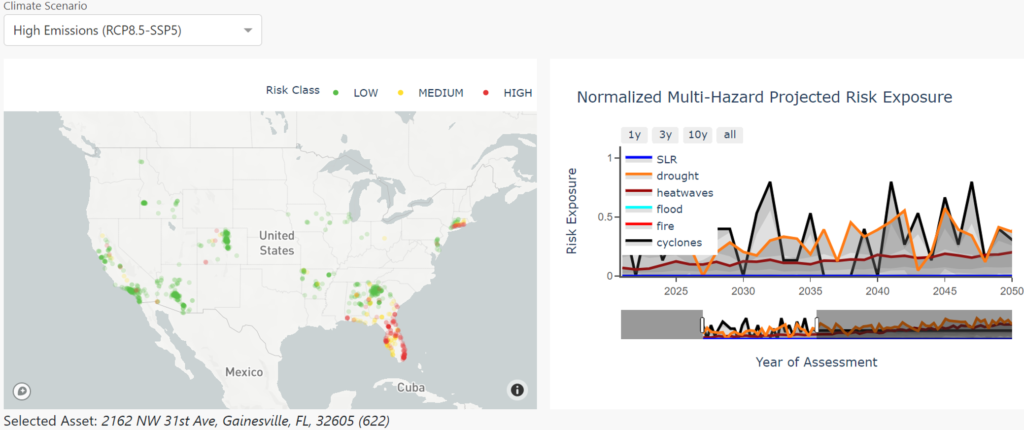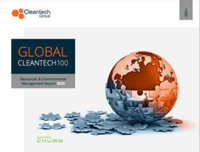Climate Risk Analytics – Tools to Navigate New Reporting Requirements
As temperatures rise, so does climate risk. Particularly of interest for corporations and governments is their exposure to physical climate risks like flood, drought, and forest fires. These risks can not only threaten companies’ physical assets but also their supply chains and operations of customers. The economic cost of extreme weather is growing exponentially, the US NOAA estimates that physical disasters in the US cost $145 billion in 2021, 40% higher than 2020 which was $102 billion. The insurance industry is covering a vast majority of these costs, with record losses the industry will continue to raise premiums to uneconomical levels both widening the coverage gap and opening the door for innovation.
In March 2022 the U.S. Securities and Exchange Commission proposed rules requiring publicly traded companies, investors, and financial firms to calculate and disclose their climate-related risk exposure and emissions. Requirements will follow both Task Force on Climate-Related Financial Disclosures (TCFD) and the Greenhouse Gas (GHG) Protocol frameworks. These SEC rules are expected to come into force at the start of 2023 at the earliest. They estimate that compliance, for both risk and emissions estimations, could cost between $490,000 – $690,000 in the first year of reporting and $420,000 – $530,000 in subsequent years, which includes internal and external resources. They also estimate workloads would entail approximately 3,400 – 4400 hours for the first year and 2900 – 3700 in subsequent years. The US follows suit of other countries with similar regulations including Switzerland, the UK, France, New Zealand, Singapore and the European Union.
With oncoming and significant reporting requirements and many without existing capacity, companies will look for cheaper, external tools to accurately report climate risk, set targets, monitor progress, and take effective and targeted actions to reduce the risks to their business – rather than build out internal teams and technology. As such, climate analytics providers meet this technology and service gap, enabling corporates and investors to accurately assess their climate risk exposure down to an asset level, integrating risks and costs of inaction and resilience measures like early warning systems for forest fires.
Early adopters of climate risk analytics are financial service institutions including insurance underwriters and asset managers, as the sector holds up to 80% of climate related losses at risk (CDP, 2019). This reality has kickstarted a shift from financial services seeing climate risk as a financial risk, just like geopolitics or low credit scores, rather than just a reputational risk. In realising the high climate risks of their investments and insured, financial services companies are also demanding high granularity climate risk data from their portfolio companies.
New innovators in this market have developed models which use geospatial climate data and scenarios to model current and future risk exposure in real-time. Most products are sold via Software as a Service (SaaS) accounts, with plug in APIs which provide risk analysis reports, data visualisation and enable real-time decisions making (see figure 1).
Examples from Sust Global’s Climate Explorer Platform demonstrate various types of climate risk data and visualizations for a portfolio of geographic locations.

Competitive Dynamics
From strong demand signals in the financial services sector, start-ups are splintering out of or developing parallel to financial services. While many incumbents in this space – ratings providers, financial sector service firms and large asset managers – are actively acquiring innovators over developing in-house tools to keep pace with demand.
Physical climate risk analytics is already embedded into the insurance industry as they have outsourced weather and disaster risk modelling software with public companies like Verisk Analytics or Corelogic. These incumbents have also started to be acquired by larger professional services firms like S&P Global. Some incumbents have also developed tools in-house with a few larger asset managers, like Blackrock and Nasdaq, have built upon their existing risk analysis infrastructure to include climate risk data.
The climate risk analytics market has become increasingly crowded, with minimal differentiation between models and most using the same climate data. Application is usually the primary differentiator. For example, Demex, which spun out from Reinsurer MunichRe, provides localized weather data, which is business specific, to provide predictions of losses from intense snowfall, rainfall and extreme temperature. This enables custom weather management solutions across property managers portfolios to make informed decisions about resiliency measures e.g. storm water drainage. Together with insurance partners Demex also offers a parametric, instant pay out, insurance product enabling businesses to respond quickly after an incident and ultimately reduce losses.
Investment
A crowded market for innovators with similar data access and modeling capacities means intense competition for funding and to differentiate services. Strategic investors include incumbents like ratings agencies who are acquiring and investing to increase risk analytics capacity for their clients e.g., S&P global and financial service firms looking to utilize the tools themselves for a competitive edge or use their networks to create new market standards for portfolio risk analysis. Impact and alternative investors like Ford Foundation are also frequent investors in this market.
Recent Deals:
- February 2022: S&P Global completed its acquisition of IHS Markit, provider of professional services information including climate risk data.
- January 2022: S&P Global acquired The Climate Service (TCS), provider of climate risk analysis for financial portfolios, with plans to integrate its Climanomics platform into ESG offering to improve transparency and provide more robust models and analytics.
- November 2021: Ford Foundation and S&P global were lead investors in Novata’s $21 million Series A round.
- September 2021: Financial services company, Moody’s invested an undisclosed amount into Fathom, provider of flood risk analytics service. Moody’s plan to integrate Fathom’s tools into its existing suit of climate risk analytics tools for its clients.
- August 2021: Fintech and cleantech investors, Group Anthemis and Blue Bear Capital invested $4.2 million in seed funding into Demex. The VC arm of insurance group QBE, QBE ventures also participated in the round.
- August 2021: Moody’s acquired risk analytics incumbent RMS, for $2 billion to improve its climate and disaster modelling capabilities
Market Outlook
We have observed start-ups splintering out of large financial institutions only to partner or obtain them as a customer at a later stage. Start-ups benefit from the agility of the start-up structure, without the red tape of a larger financial institutions, while scale-ups benefit from broad networks of incumbents who are already offering similar services to their clients. However, the sector is very relationship oriented, generally risk adverse and slow to adopt new technologies. Therefore, if start-ups fail to secure these rare relationships in the short term, they may lose steam before really getting going.
Oncoming mandatory disclosures have the potential to provide the impetus needed to see true strategic risk integration. But in the case of the SEC, there has been some push-back from companies who claim climate is not a significant enough risk for them and that rules are far-reaching.
There also remains issues with the accuracy of existing tools – some companies have reported inconsistent findings when implementing different models with differing degrees of granularity. However, most regulations align with the TCFD framework and it’s reporting requirements, which should allow for some degree of cohesion and compatibility.
Another area of contention is the frequency which companies report, with doubt that an annual report could impact day-to-day decision making. However, real-time analytics are table stakes for these innovators, with many able to integrate APIs into existing software used by infrastructure designers or underwriting software in insurance. We also see corporates and investors requiring advisory services to action the data into adaptation measures and response strategies and expect more innovators offer these as they try to differentiate themselves.
What to look out for?
The climate risk analysis and emissions monitoring innovation ecosystems go hand-in-hand for corporates having to disclose their climate impact. The emissions monitoring or carbon accountancy market is providing corporates and individuals with tools to capture, aggregate and analyse their carbon footprint. Some innovators are starting to offer both climate risk analytics and emissions monitoring services e.g. SinAI, which can further reduce reporting burdens. We expect to see further convergence of these markets via mergers and partnerships between innovators in these markets and further acquisitions from incumbents.
Cleantech Group will be exploring this dynamic further in oncoming research on Carbon Accounting, mapping the key players, drivers, challenges, and regulatory impacts. If you would like to be included or have access to this do get in touch with Lead Analyst, Holly Stower.



